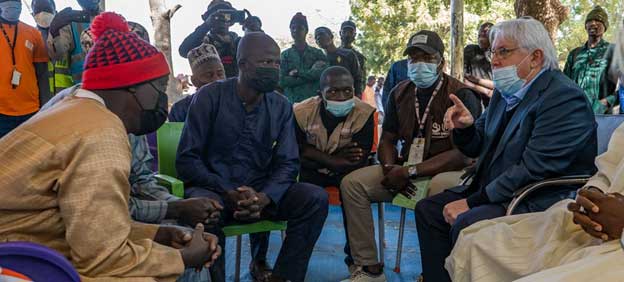[ad_1]
After 4 days of combating in Ukraine, it’s not going particularly properly for Russian forces. According to Ukraine’s defense ministry, Russia has misplaced about 4,300 troops and practically 150 tanks, and each Kyiv, the capital, and Kharkiv, Ukraine’s second-largest metropolis, are nonetheless beneath Ukrainian management.
Casualty numbers are unverified and needs to be handled with some warning, however they’re nonetheless a pointy distinction to preliminary Russian expectations, which assumed the Russian armed forces’ higher numbers and entry to extra superior weapons programs would lead to a swift, comparatively painless invasion. Ukrainian forces, nonetheless, have mounted a strikingly profitable resistance.
Lately, a lot has been product of Russia’s growing hybrid warfare, fusing typical ways like floor troops and air campaigns alongside data manipulation and digital warfare like sign jamming. Nonetheless, on the data entrance, Russia appears to be dropping the conflict; the sheer quantity of video and data coming from Ukraine in actual time, plus a younger, social media-savvy president and broad, clear intelligence sharing, have proved to be a robust antidote to the Kremlin’s disinformation spin.
“It’s been attention-grabbing to look at within the final 48 hours, and good to see in some ways, that the Kremlin has misplaced management of the narrative, internationally, round this conflict,” Mason Clark, the lead Russia analyst on the Institute for the Research of Battle, a nonpartisan DC-based assume tank, informed Vox.
The battle can also be markedly completely different than different latest conflicts, equivalent to these in Syria or Afghanistan. Regardless of the disparities between Russian and Ukrainian forces, it’s nonetheless a conflict between two formal militaries, versus a decentralized insurgency.
Ukraine’s country-wide mobilization provides an extra component, with many civilians selecting up weapons, studying to make Molotov cocktails, or just confronting tanks within the street.
Clark spoke with Vox on February 26 about his observations of the battle to date, the way it compares with different latest conflicts, and the sources Russia remains to be holding in reserve.
The dialog, edited for size and readability, is under.
Ellen Ioanes
Are you able to stroll me by means of among the modifications and upgrades that the Russian armed forces have been engaged on prior to now decade or two?
Mason Clark
So, the quick reply is that truly plenty of their tools has not modified. A whole lot of the Russian and Ukrainian forces are nonetheless combating with roughly on-par tools with one another. There’s some Russian items which have higher tools, newer tanks, that form of factor. However on the entire, a lot of it because of simply the sheer value of changing Russia’s previous stock of kit and weaponry and munitions, even, implies that they’re not that a lot completely different materially than they’d have been at first of the conflict in 2014.
The primary factor that the Russian navy has emphasised as actually bettering is, surprisingly sufficient, capabilities that we haven’t actually seen them use within the conflict to date. One, digital warfare, which we’ve got not seen employed at scale. And two, plenty of numerous types of new weapons, both cruise missiles or new fighters, and strategic bombers that Russian doctrine — what they are saying they’d do on this form of conflict — we haven’t really seen.
And I can delve just a little bit [into] why we predict that’s. It seems Putin has wildly miscalculated and had a, frankly, dangerous plan going into this of how rapidly the Ukrainian navy would collapse, and remains to be making an attempt to keep away from utilizing these very damaging weapons of concentrated missiles and airstrikes to destroy Ukrainian defensive positions, to protect his narrative of this not being an actual conflict and never requiring that form of use of firepower.
Ellen Ioanes
Proper, form of a diminishing expectation of the enemy that they’re up towards.
Mason Clark
Precisely. And, after all, as we’ve now seen within the final 72 hours … to be clear, it’s not simply that the Russians are doing badly, it’s additionally that the Ukrainian navy is doing very properly, placing up a really, very stiff protection in a number of areas. However seemingly what we’re apprehensive about right here at ISW and watching on the staff over the subsequent 48 hours is when, and if, the Russians will recalibrate their strategy and shift again into deploying further forces ahead, and utilizing these rather more damaging approaches as they begin combating by means of Kyiv or Kharkiv, or as they begin to push ahead into Zaporizhzhya [a city in southeastern Ukraine] — they’re approaching the outskirts [on Saturday]. As damaging because the strikes on Kyiv and different cities have been to date, we haven’t actually seen the complete capabilities that the Russian navy has and may deliver to bear, the way in which it has, for instance, in Syria, or in combating in Chechnya within the early 2000s.
Ellen Ioanes
Proper, so talking of earlier conflicts, there are a few similarities, or doable similarities — equivalent to, what we’ve heard of the bombing of hospitals, and I really feel like I’ve motive to consider that’s true — however will these ways like we noticed in Syria be doable in such a magnified, and really scrutinized, panorama as we’re working with now?
Mason Clark
They’re doable, and sadly I don’t assume we will rule out that Russian forces will start to hold out these strikes on a extra overt scale, regardless that, [in the] final 24 hours the Ukrainian navy has been reporting that Russian forces have been hanging residential areas, simply strictly to trigger intimidation and terror and, most likely, to drive a collapse of the Ukrainian navy — that hasn’t occurred in any respect.
However as you raised, even with all the gaps, the fog of conflict, and that reporting on actual management of terrain and issues like that, there’s a lot video rising from the combating on the bottom and documentation of Russian actions, and explicit violations towards civilians and strikes on civilian targets, that in some ways, it’s been attention-grabbing to look at within the final 48 hours, and good to see, in some ways, that the Kremlin has misplaced management of the narrative internationally round this conflict.
Ellen Ioanes
So, I believe one other level to that, by way of the data and what we’re capable of see and doc, part of Russia’s hybrid warfare that I really feel like everybody and their mother has been speaking about for a number of years, doesn’t appear to be working right here.
Mason Clark
No, and I might agree, and that’s been an attention-grabbing facet of this. They’ve misplaced management of the narrative fully, even into Russian home audiences. I believe Putin is dealing with extra pushback than he anticipated. One in all my colleagues, Katya, we ran an replace on this final evening. It’s attention-grabbing, Russian media is solely not portraying the conflict.
To this point, they’re claiming that the one combating that’s taking place is across the Donetsk and Luhansk Individuals’s Republics, the proxies that Russia acknowledged, and so they’re not displaying combating throughout the nation, they’re not displaying any Russian casualties, and slightly than displaying Russian footage, they’re making an attempt to take Ukrainian footage out of context and use that to painting the conflict. And even then, they’re dealing with giant backlash from the inhabitants, and the early stirrings of what might cohere into a real anti-war motion, which might be fairly the feat contemplating how built-up the Russian repressive equipment has been the previous few years.
On these wider hybrid strategies, it appears that evidently this has been, I might say, not essentially a break from them, as a result of we assess that this was not Putin’s first alternative. This appears to be one thing he has been compelled into after a protracted interval of a buildup and making an attempt to coerce calls for out of each Ukraine and NATO, and specifically, I believe US intelligence did an excellent job, in addition to with European allies, of exposing so a lot of what had been extra of these hybrid strategies that the Kremlin was utilizing all through December to February.
For instance, considering of the a number of stories of Russian plans for a coup in Kyiv, and the truth that they even picked out the those that they wished to take over the federal government, or US intelligence exposing in late January that the Russian navy had filmed a faux video of civilians being killed by Ukrainian forces, that form of factor. I believe that there’s a really excessive probability that that’s how the Kremlin wished this conflict to start, with some form of muddled factor that they had been capable of physician and spin within the data area. However as a result of so a lot of these had been uncovered, they’ve had to do that very overt, direct invasion of Ukraine.
Ellen Ioanes
Proper, it appeared as if there have been many makes an attempt at narrative-spinning, from “Oh, Ukraine has all the time been part of Russia, we’re the identical individuals,” after which, abruptly, “Ukraine is committing genocide towards Russian individuals,” which you’ll’t do in the event you’re the identical individuals — you realize, these form of combined messages.
Mason Clark
A nuance on that, that’s really essential to seize on how Putin is spinning this conflict at house is, the Kremlin and the Kremlin-run media is making an attempt to attract a really sharp distinction between the Ukrainian inhabitants, which they appear to count on will greet Russia as liberators and Russia has no quarrel with them, and the regime in Kyiv, which they painting as being neo-Nazis and drug customers. I have no idea the place that one got here from. And it’s this attention-grabbing stability the place I believe it’s a mixture of them making an attempt to pitch to the Russian those that this isn’t a conflict towards Ukraine, it’s a really focused intervention to eliminate the regime.
However on the identical time, we’re having this rising view that we, frankly, had been improper about how rational the Kremlin was, to be trustworthy, and it appears very a lot that they appear to have drunk their very own Kool-Assist, so to talk. They could have really believed that each one they wanted to do was take out the federal government in Kyiv that they do see as this foreign-imposed fascist authorities, and the Ukrainian inhabitants can be fully okay with that, which is simply, fairly merely, as everyone seems to be seeing, not the case.
Ellen Ioanes
Is that a sign that Putin is, possibly, minimize off from actuality a bit, if certainly that’s the perception? As a result of I’m unsure, if we’re working beneath the concept that he does consider that Ukrainians will welcome Russians with open arms, I don’t see that as the identical sentiment or motivating concept as Chechnya or Georgia, the place it was like, we’ve got to deliver these again into the fold, we’ve got to overcome these areas. Are you able to draw that parallel in any respect?
Mason Clark
It’s a tough one, as a result of Chechnya was framed as extra of a home terrorism difficulty, and Georgia — there are actually some parallels in among the broad strokes of defending a separatist enclave in South Ossetia and Abkhazia, after all, and evaluating that to the Donetsk and Luhansk Individuals’s Republics, however the framing could be very a lot completely different. Even the 2008 conflict with Georgia was framed as a purely defensive measure to guard these enclaves. There was no framing in any respect of it being a conflict of reconquest or to deliver Georgia again into the fold or something like that, the place this Ukraine battle very a lot has been.
In your first level, I wish to hesitate, as a result of I don’t wish to fall into the entice of armchair psychology, of ascribing a motive to it, however briefly, sure, it does appear that one thing has shifted in Putin’s strategy. It may very well be his mind-set — the favored concept going round is that each one of his isolation the final two years throughout Covid has actually gotten to him; he appears to be listening to completely different individuals in his authorities than he used to, and there’s been plenty of leaks — that haven’t been totally confirmed — that he’s not listening to correct navy recommendation, and that Russian navy officers are additionally sad with this plan and the conflict as an entire. I don’t assume I can assess why, however I might agree, at minimal, that this isn’t the identical Putin that we had been watching two years in the past.
Ellen Ioanes
Together with the mobilization of Ukrainian volunteers and civil society, there’s a robust want to combat and to work collectively in solidarity that you simply see in Ukraine, and folks have been coaching for this for eight years. In fact, Russia has a a lot bigger navy, however I don’t know what their coaching seems to be like. Are you able to say how well-trained these troops are?
Mason Clark
That’s really a really, very attention-grabbing query, and one of many strangest quirks of watching this offensive in movement, from a Russian doctrinal facet, which is what I’ve spent the previous few years finding out — primarily their coaching and classes realized from Syria and different conflicts. The quick reply is that this doesn’t make sense, this doesn’t comply with Russian doctrine and every part that they need to be doing, in response to their very own procedures.
On the decrease finish of the spectrum, [Russia is] nonetheless predominantly a conscript-based navy. It has points, and we’re seeing that now on the entrance line, with plenty of items surrendering. There’s been a number of stories of Russian troops being taken prisoner and principally telling Ukrainians, “We came upon about this invasion three hours earlier than you probably did. We thought we had been really on workout routines, after which all of the sudden we had been informed to cross the border.”
There are good parts of the Russian navy — notably the First Guards Tank Military that’s based mostly round Moscow, and we’ve seen some parts of them round jap Ukraine, however rather more importantly, we’re seeing a large disparity between the items within the south transferring north from Crimea, [which] are simply functioning a lot, a lot better than these coming from the northeastern Ukrainian border and from Belarus.
And we predict the rationale behind that — and that is one thing we noticed within the months main as much as this, and albeit thought that Putin was not going to launch this offensive — is that solely the troops dealing with Donbas and Crimea, within the southern navy district, had been prepared and truly exercising at a big scale — whole divisions and regiments had been finishing up these workout routines. All the troops that had been on the northeastern Ukrainian border and in Belarus had been pulled from all throughout Russia. We’re seeing items that had been based mostly on the Pacific coast which were pulled all the way in which into Belarus and are actually being thrown into northern Ukraine, and so they didn’t appear to have time to prepare collectively, and kind these cohesive command buildings.
So now we’re seeing them run into issues with logistics, working out of gasoline, dangerous maps, all kinds of different issues. And that’s having prices for the Russian navy. The frankly unusual factor about that is that, to be glib about it, they need to be smarter than this. Once more, we assessed till about 5 days earlier than this started, that there can be no means they’d be launching an offensive from the northeast as a result of they simply weren’t postured to do it — however they appear to have gone forward with these forces anyway, which undoubtedly lends credence to the arguments that this very a lot has been a Putin resolution, he’s not listening to good navy recommendation.
Ellen Ioanes
That has occurred to me as properly, by way of the shortage of use of their sea energy. Now we have the story from Snake Island, and Russia has a way more highly effective navy, so it’s very unusual that that has not been exploited — or it’s unusual to me, as an outsider.
Mason Clark
I might agree fully. And we haven’t essentially seen Russian strikes to take out the Ukrainian Navy — there’s been some very minor skirmishing from patrol boats, actually, however there hasn’t been a lot by way of precise assaults. Now, the Russian Navy and notably the Black Sea fleet and a few of their vessels pulled in from the Mediterranean and whilst distant because the Baltic, are actually finishing up a blockade of Ukrainian ports and stopping Ukrainian ships from breaking out, however we haven’t seen them used, I believe, for 2 causes: One, the identical level usually [why] the Russians haven’t used as a lot air energy and airstrikes is, fairly merely, making an attempt to downplay this and never get to that degree.
The second is, they might not have drawn up the plans and been ready to. We additionally haven’t seen any use of Russian naval infantry, which is their equal of Marines, being deployed, which was an enormous factor that plenty of people forecasted previous to the offensive. There’s very a lot been this focus of this floor breakout from Crimea, over every part else. A middling speculation is we predict they might simply be making an attempt to safe ports with these floor forces earlier than with the ability to land and transfer vessels in to offer additional fireplace help, as a result of they don’t wish to danger the price of having a naval touchdown go improper.
Amphibious landings are fairly tough in even one of the best of circumstances, and so they most likely would take heavy casualties in the event that they tried to do any of the direct landings towards Mariupol or Odesa or any of these different main coastal cities. Nevertheless it has certainly been an attention-grabbing hole within the capabilities that they’ve used to date.
Ellen Ioanes
That additionally leaves room for escalation, then, too.
Mason Clark
Precisely, and I hate to have to finish it on this level, nevertheless it’s been attention-grabbing watching the reporting of how properly the Ukrainian navy has been doing the previous few days — and so they have been doing very properly, there have been plenty of Russian errors — however I want I may say, “Subsequently I believe the Ukrainian navy’s going to carry out.”
Sheer weight of numbers, and if the Russians do begin utilizing the sources that they’ve, are going to overwhelm the Ukrainian navy sooner or later, nearly irrespective of how badly [Russia runs] this marketing campaign plan.
And there are such a lot of property that haven’t been put into play but, that what we’re actually going to be watching within the subsequent 48 to 72 hours is that if the Russians resolve to vary tack and begin utilizing these. Significantly as Russian forces transfer into Kyiv correct, as a result of we haven’t seen the Russians use armor and heavy artillery towards an city goal but, and so they completely have the aptitude to take action, in the event that they resolve to desert the strategy they appear to be taking: of not taking the hit within the data area, of destroying giant swaths of Ukraine and killing civilians.
Ellen Ioanes
This looks as if a conflict from a time forgotten, just a little bit. It looks as if a battle from World Battle II, in a means. It does appear to be a really peculiar city warfare, typical navy marketing campaign.
Mason Clark
Certain, and there’s undoubtedly elements of that. I do assume we’ve seen plenty of key variations in, actually, the tempo of among the combating and using what we’ve got seen by way of artillery and air help, and among the key variations of how lined this has been on social media, and the significance of those narratives.
However I do agree, it has been very attention-grabbing observing it as, aside from [Operation Desert Storm in] 1991 and [the invasion of Iraq in] 2003, this large-scale, typical warfare and sweeping armored offense — or not so sweeping, as a result of the Russians haven’t been doing properly — [we haven’t seen that] for many years and a long time.
[ad_2]
Source link















